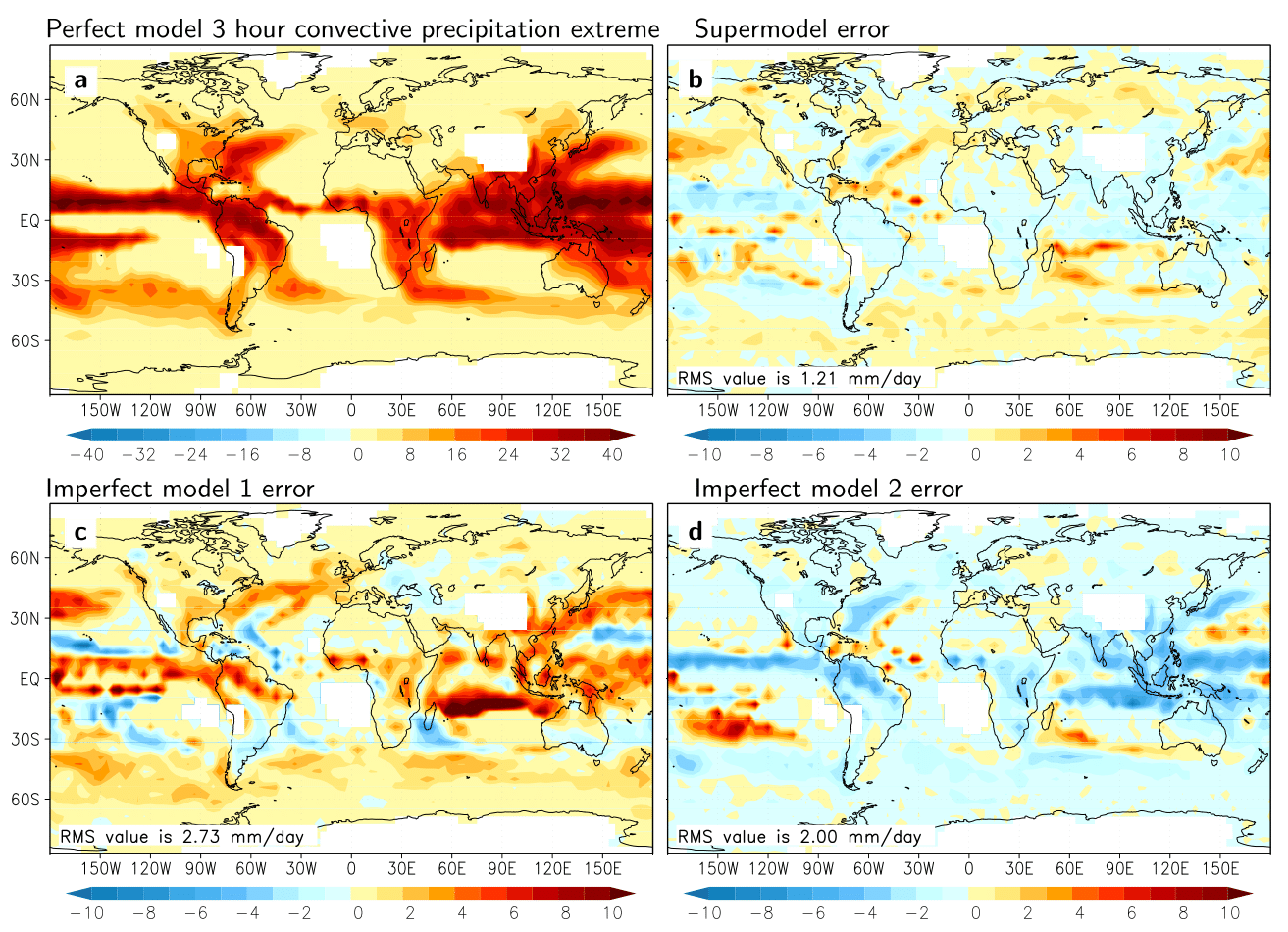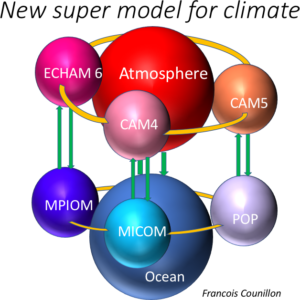Context for the supermodeling approach

supermodel (b) and the two imperfect models (c) and (d). Adapted from Selten et al., 2017.
Climate prediction is the next frontier in climate research. Prediction of climate on timescales from a season to a decade has shown progress, but beyond the ocean skill remains low. And while the historical evolution of climate at global scales can be reasonably simulated, agreement at a regional level is limited and large uncertainties exist in future climate change. These large uncertainties pose a major challenge to those providing climate services and to informing policy makers.
The STERCP project investigated the potential of an innovative technique to reduce model systematic error, and hence to improve climate prediction skill and reduce uncertainties in future climate projections. The current practice to account for model systematic error, as for example adopted by the Intergovernmental Panel on Climate Change, is to perform simulations with ensembles of different models. This leads to more reliable predictions, and to a better representation of climate. Instead of running models independently, STERCP and following projects propose to connect the different models in manner that they synchronize and errors compensate, thus leading to a model superior to any of the individual models – a supermodel.
The concept stems from theoretical non-dynamics and relies on advanced machine learning algorithms. Its application to climate modelling has been rudimentary. Nevertheless, our initial results show it holds great promise for improving climate prediction. To achieve even greater gains, we extend the approach to allow greater connectivity among multiple complex climate models to create a true super climate model. We assess the approach’s potential to enhance seasonal-to-decadal prediction, focusing on the Tropical Pacific and North Atlantic, and to reduce uncertainties in climate projections. Importantly, this work will improve our understanding of climate, as well as how systematic model errors impact prediction skill and contribute to climate change uncertainties.
Pioneering the supermodelling approach for earth system models: the STERCP project.
- STERCP developed three-level hierarchy of climate supermodels
(1) Supermodels using the interactive ensemble approach. In this class of supermodel the different models are connected only via the ocean-atmosphere interface. A standard interactive ensemble consists of different realisations of identical atmospheric models coupled to a single ocean model. In the supermodel the atmospheric models differ in terms of their physical parameterisations and their interaction with the ocean is optimised to reduce model error.
(2) Supermodels using an intermediate complexity climate model. Here the three-dimensional atmospheric states of the different component models are connected, while each atmospheric model is again coupled to the same ocean model. Several configurations differing in the number of atmospheric models and the method to couple them have been developed. These models have been used to develop strategies for training and coupling full complexity Earth System Models (ESMs).
(3) Supermodels that connect three state-of-the-art ESMs their three dimensional atmospheric and oceanic states. We have developed one version of this supermodel in which the three ESMs are connected by their oceanic components. First simulations with this model have shown that the ocean states of three models can be synchronised over much of the global ocean. Thus, this approach is more powerful than the interactive ensemble approach, which achieves synchronization only in the tropical Pacific.

- STERCP used advanced machine learning and data assimilation schemes to train and connect models
STERCP developed software and machine learning algorithms to efficiently connect and train supermodels based on complex ESMs. To connect ocean components we apply advanced data assimilation methods to synchronize the models on a common ocean state every month. To connect atmospheric components we nudge them to a common atmospheric state every six hours. The common state is an optimal weighted sum of the individual model components. Two training schemes have been developed to determine the optimal weights: synchronised based learning and cross-pollination in time. Both schemes are designed to give larger weight to those models that most reduce the supermodel error.
- STERCP developed two new approaches to study climate variability
These are a direct spinoff from the work in developing the supermodels. In the first, we have developed a regional coupled interactive ensemble. The interactive ensemble is a useful tool to extract patterns of climate variability caused by two-way interaction between the ocean and the atmosphere. We apply this method regionally and have also developed a new approach to retain synoptic scale weather variations. In the second, we have developed a partial coupled approach to study the impact of wind driven ocean variability on the atmosphere, while maintaining consistent thermodynamic interaction between ocean and atmosphere.
- STERCP achieved the following key results:
(1) The power of the supermodel approach to improve the representation of tropical Pacific climate was demonstrated using supermodels based on the interactive ensemble. In particular, this class of supermodel was able to largely eliminate errors in rainfall and sea surface temperature that have persisted across generations of climate models. This level of error reduction could not be achieved by averaging independently performed simulations, as traditionally done. The supermodel is superior because as an interactive ensemble it can extract benefit from non-linear ocean-atmosphere interaction.
(2) The potential to extend supermodelling to global climate prediction was demonstrated using an intermediate complexity supermodel with synchronised (three-dimensional) atmospheric states. The supermodel was trained in a perfect model configuration using a synchronization-based learning algorithm. The supermodel’s climatology and its climate change projections were closer to the perfect model, as compared to the imperfect models and the standard multi-model ensemble average. This shows the potential of the supermodel approach to improve climate predictions.
(3) We investigated the relation between model error and uncertainties in climate predictions. In particular, we have shown that climatological errors strongly alter the nature of climate variability, degrade seasonal prediction skill, and introduce uncertainties in climate change over the tropics. We have shown that the poor representation of local convective processes degrades skill in predicting Ethiopian boreal summer rainfall, and that the erroneous response to global warming degrades skill in predicting Sahel rainfall.
- STERCP will progress beyond the state-of-the-art in the three areas:
Firstly, STERCP will extend the supermodel approach to allow greater connectivity among multiple complex climate models. Thus, we aim to produce a dynamical model superior to the individual models constituting it, and superior to any post priori weighted ensemble of simulations performed with those models unconnected.
Secondly, STERCP aims to demonstrate that climate predictions with a supermodel are more skilful than predictions performed with its unconnected component models. We aim to demonstrate improvements both for seasonal and multi-year climate prediction, with particular focus on the tropical Pacific and North Atlantic.
Thirdly, STERCP aims to provide more reliable long-term climate projections. We will relate uncertainties in climate projections to the performance of models in simulating and predicting present day climate. Showing the superiority of the supermodel approach with respect to these metrics will evidence the greater reliability of the supermodel in climate change projections as compared to its individual component models.